automatic transmission fluid SAAB 9-3 2000 Owners Manual
[x] Cancel search | Manufacturer: SAAB, Model Year: 2000, Model line: 9-3, Model: SAAB 9-3 2000Pages: 236, PDF Size: 10.85 MB
Page 6 of 236
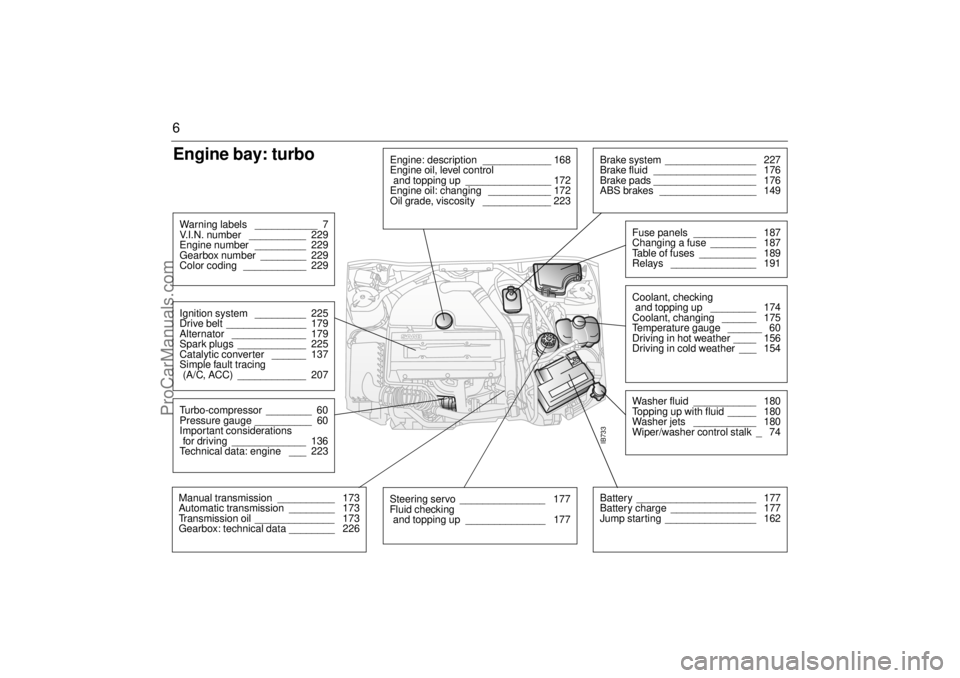
6Engine bay: turboWarning labels ___________ 7
V.I.N. number __________ 229
Engine number _________ 229
Gearbox number ________ 229
Color coding ___________ 229Ignition system _________ 225
Drive belt ______________ 179
Alternator _____________ 179
Spark plugs ____________ 225
Catalytic converter ______ 137
Simple fault tracing
(A/C, ACC) ____________ 207Turbo-compressor ________ 60
Pressure gauge __________ 60
Important considerations
for driving _____________ 136
Technical data: engine ___ 223Manual transmission __________ 173
Automatic transmission ________ 173
Transmission oil ______________ 173
Gearbox: technical data ________ 226
Battery _____________________ 177
Battery charge _______________ 177
Jump starting ________________ 162IB733
Engine: description ____________ 168
Engine oil, level control
and topping up _______________ 172
Engine oil: changing ___________ 172
Oil grade, viscosity ____________ 223
Washer fluid ___________ 180
Topping up with fluid _____ 180
Washer jets ___________ 180
Wiper/washer control stalk _ 74
Steering servo _______________ 177
Fluid checking
and topping up ______________ 177
Coolant, checking
and topping up ________ 174
Coolant, changing ______ 175
Temperature gauge ______ 60
Driving in hot weather ____ 156
Driving in cold weather ___ 154Fuse panels ___________ 187
Changing a fuse ________ 187
Table of fuses __________ 189
Relays _______________ 191
Brake system ________________ 227
Brake fluid __________________ 176
Brake pads __________________ 176
ABS brakes _________________ 149
ProCarManuals.com
Page 57 of 236
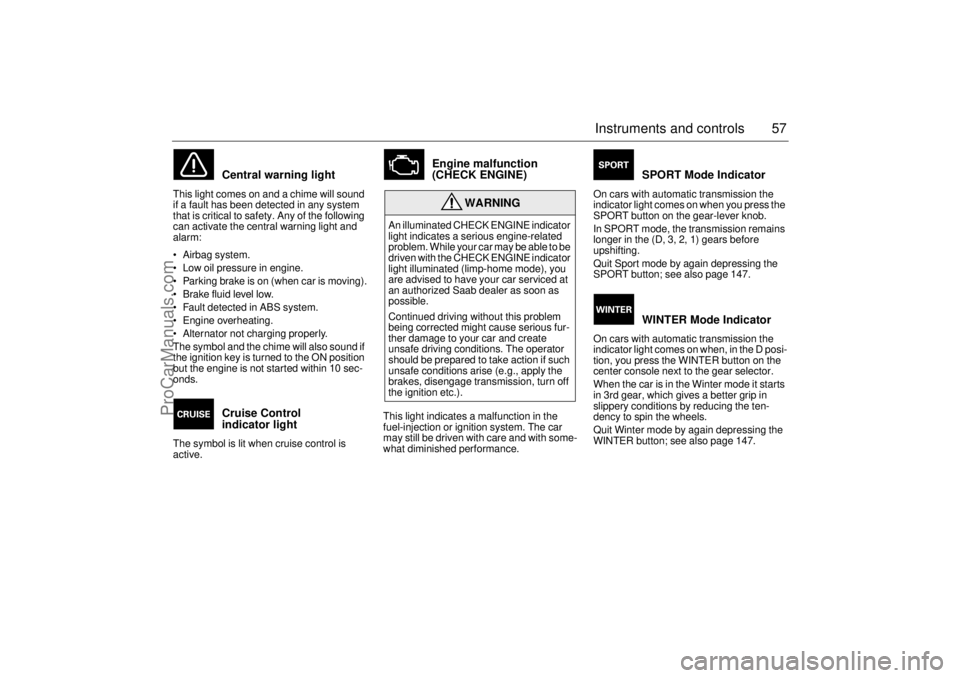
57 Instruments and controls
Central warning light
This light comes on and a chime will sound
if a fault has been detected in any system
that is critical to safety. Any of the following
can activate the central warning light and
alarm:
Airbag system.
Low oil pressure in engine.
Parking brake is on (when car is moving).
Brake fluid level low.
Fault detected in ABS system.
Engine overheating.
Alternator not charging properly.
The symbol and the chime will also sound if
the ignition key is turned to the ON position
but the engine is not started within 10 sec-
onds.
Cruise Control
indicator light
The symbol is lit when cruise control is
active.
Engine malfunction
(CHECK ENGINE)
This light indicates a malfunction in the
fuel-injection or ignition system. The car
may still be driven with care and with some-
what diminished performance.
SPORT Mode Indicator
On cars with automatic transmission the
indicator light comes on when you press the
SPORT button on the gear-lever knob.
In SPORT mode, the transmission remains
longer in the (D, 3, 2, 1) gears before
upshifting.
Quit Sport mode by again depressing the
SPORT button; see also page 147.
WINTER Mode Indicator
On cars with automatic transmission the
indicator light comes on when, in the D posi-
tion, you press the WINTER button on the
center console next to the gear selector.
When the car is in the Winter mode it starts
in 3rd gear, which gives a better grip in
slippery conditions by reducing the ten-
dency to spin the wheels.
Quit Winter mode by again depressing the
WINTER button; see also page 147.
WARNING
An illuminated CHECK ENGINE indicator
light indicates a serious engine-related
problem. While your car may be able to be
driven with the CHECK ENGINE indicator
light illuminated (limp-home mode), you
are advised to have your car serviced at
an authorized Saab dealer as soon as
possible.
Continued driving without this problem
being corrected might cause serious fur-
ther damage to your car and create
unsafe driving conditions. The operator
should be prepared to take action if such
unsafe conditions arise (e.g., apply the
brakes, disengage transmission, turn off
the ignition etc.).
ProCarManuals.com
Page 144 of 236
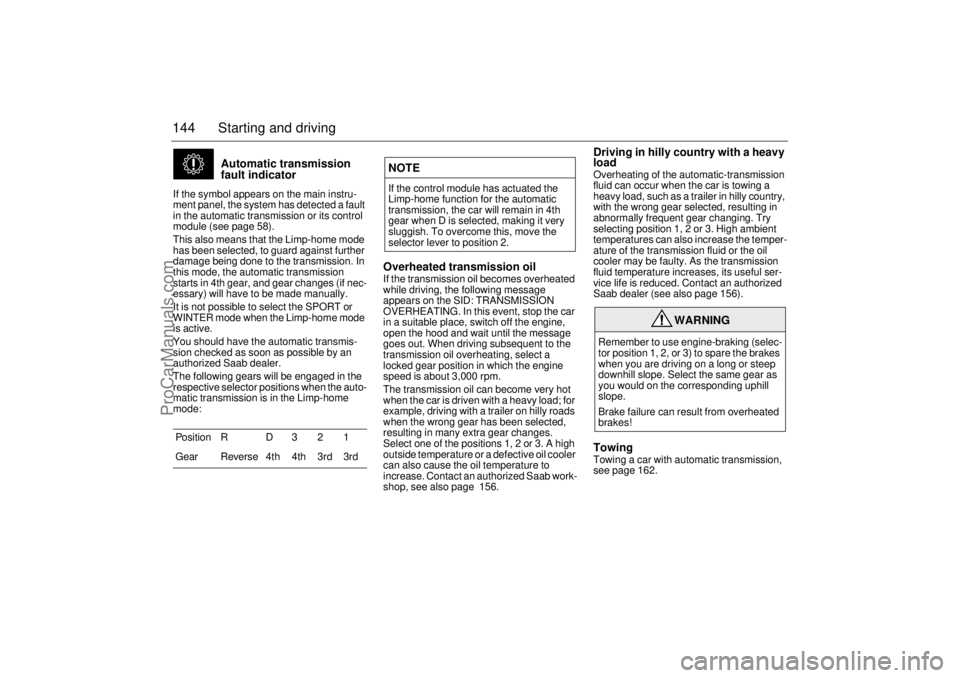
144 Starting and driving
Automatic transmission
fault indicator
If the symbol appears on the main instru-
ment panel, the system has detected a fault
in the automatic transmission or its control
module (see page 58).
This also means that the Limp-home mode
has been selected, to guard against further
damage being done to the transmission. In
this mode, the automatic transmission
starts in 4th gear, and gear changes (if nec-
essary) will have to be made manually.
It is not possible to select the SPORT or
WINTER mode when the Limp-home mode
is active.
You should have the automatic transmis-
sion checked as soon as possible by an
authorized Saab dealer.
The following gears will be engaged in the
respective selector positions when the auto-
matic transmission is in the Limp-home
mode:
Overheated transmission oilIf the transmission oil becomes overheated
while driving, the following message
appears on the SID: TRANSMISSION
OVERHEATING. In this event, stop the car
in a suitable place, switch off the engine,
open the hood and wait until the message
goes out. When driving subsequent to the
transmission oil overheating, select a
locked gear position in which the engine
speed is about 3,000 rpm.
The transmission oil can become very hot
when the car is driven with a heavy load; for
example, driving with a trailer on hilly roads
when the wrong gear has been selected,
resulting in many extra gear changes.
Select one of the positions 1, 2 or 3. A high
outside temperature or a defective oil cooler
can also cause the oil temperature to
increase. Contact an authorized Saab work-
shop, see also page 156.
Driving in hilly country with a heavy
loadOverheating of the automatic-transmission
fluid can occur when the car is towing a
heavy load, such as a trailer in hilly country,
with the wrong gear selected, resulting in
abnormally frequent gear changing. Try
selecting position 1, 2 or 3. High ambient
temperatures can also increase the temper-
ature of the transmission fluid or the oil
cooler may be faulty. As the transmission
fluid temperature increases, its useful ser-
vice life is reduced. Contact an authorized
Saab dealer (see also page 156).TowingTowing a car with automatic transmission,
see page 162. Position R D 3 2 1
Gear Reverse 4th 4th 3rd 3rd
NOTEIf the control module has actuated the
Limp-home function for the automatic
transmission, the car will remain in 4th
gear when D is selected, making it very
sluggish. To overcome this, move the
selector lever to position 2.
WARNING
Remember to use engine-braking (selec-
tor position 1, 2, or 3) to spare the brakes
when you are driving on a long or steep
downhill slope. Select the same gear as
you would on the corresponding uphill
slope.
Brake failure can result from overheated
brakes!
ProCarManuals.com
Page 147 of 236
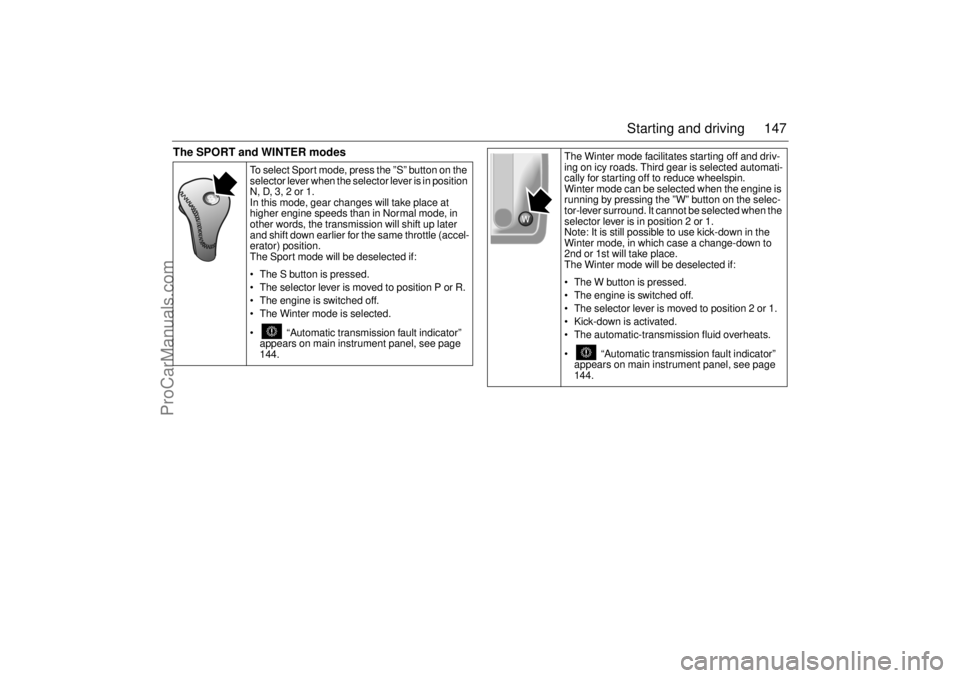
147 Starting and driving
The SPORT and WINTER modes
To select Sport mode, press the ”S” button on the
selector lever when the selector lever is in position
N, D, 3, 2 or 1.
In this mode, gear changes will take place at
higher engine speeds than in Normal mode, in
other words, the transmission will shift up later
and shift down earlier for the same throttle (accel-
erator) position.
The Sport mode will be deselected if:
The S button is pressed.
The selector lever is moved to position P or R.
The engine is switched off.
The Winter mode is selected.
“Automatic transmission fault indicator”
appears on main instrument panel, see page
144.
The Winter mode facilitates starting off and driv-
ing on icy roads. Third gear is selected automati-
cally for starting off to reduce wheelspin.
Winter mode can be selected when the engine is
running by pressing the ”W” button on the selec-
tor-lever surround. It cannot be selected when the
selector lever is in position 2 or 1.
Note: It is still possible to use kick-down in the
Winter mode, in which case a change-down to
2nd or 1st will take place.
The Winter mode will be deselected if:
The W button is pressed.
The engine is switched off.
The selector lever is moved to position 2 or 1.
Kick-down is activated.
The automatic-transmission fluid overheats.
“Automatic transmission fault indicator”
appears on main instrument panel, see page
144.
ProCarManuals.com
Page 173 of 236
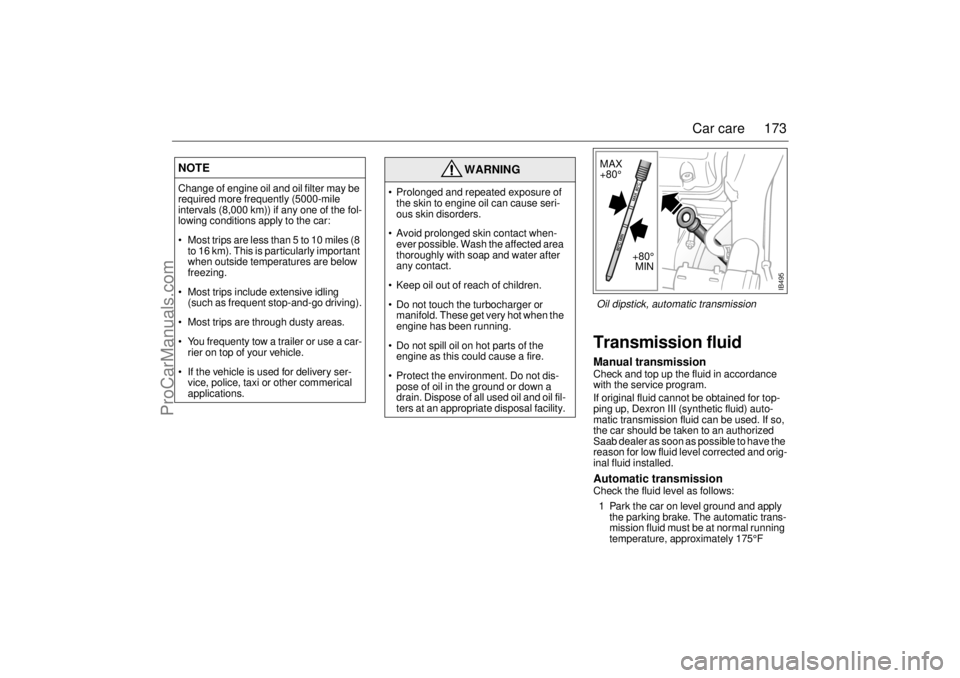
173 Car care
Transmission fluidManual transmissionCheck and top up the fluid in accordance
with the service program.
If original fluid cannot be obtained for top-
ping up, Dexron III (synthetic fluid) auto-
matic transmission fluid can be used. If so,
the car should be taken to an authorized
Saab dealer as soon as possible to have the
reason for low fluid level corrected and orig-
inal fluid installed.Automatic transmissionCheck the fluid level as follows:
1 Park the car on level ground and apply
the parking brake. The automatic trans-
mission fluid must be at normal running
temperature, approximately 175°F
NOTEChange of engine oil and oil filter may be
required more frequently (5000-mile
intervals (8,000 km)) if any one of the fol-
lowing conditions apply to the car:
Most trips are less than 5 to 10 miles (8
to 16 km). This is particularly important
when outside temperatures are below
freezing.
Most trips include extensive idling
(such as frequent stop-and-go driving).
Most trips are through dusty areas.
You frequenty tow a trailer or use a car-
rier on top of your vehicle.
If the vehicle is used for delivery ser-
vice, police, taxi or other commerical
applications.
WARNING
Prolonged and repeated exposure of
the skin to engine oil can cause seri-
ous skin disorders.
Avoid prolonged skin contact when-
ever possible. Wash the affected area
thoroughly with soap and water after
any contact.
Keep oil out of reach of children.
Do not touch the turbocharger or
manifold. These get very hot when the
engine has been running.
Do not spill oil on hot parts of the
engine as this could cause a fire.
Protect the environment. Do not dis-
pose of oil in the ground or down a
drain. Dispose of all used oil and oil fil-
ters at an appropriate disposal facility.
+80°
MIN MAX
+80°
IB495
Oil dipstick, automatic transmission
ProCarManuals.com
Page 174 of 236

174 Car care
(80°C). This can be achieved by driving
the car for about 30 min on the open
road.
2 With the engine idling, move the selector
lever to D and wait for at least
15 seconds. Next, move the selector
lever to R and wait for 15 seconds again.
Finally, move the selector lever to P. Let
the engine idle.
3 Wipe the dipstick clean with a lint-free
cloth and put it back.
4 With the fluid at normal temperature, the
level should be between the MAX and
MIN marks on the dipstick. Top up, as
necessary, with Texaco Texamatic
Dexron III automatic-transmission fluid,
adding it through the dipstick pipe. The
distance between the MIN and MAX
marks on the dipstick corresponds to a
volume of approximately 0.4 qts
(0.4 litre).
If the outside temperature is below 50°F
(10°C), the fluid will not reach the specified
temperature of 175°F (80°C). In this case,
the correct fluid level may be 0.8 in (20 mm)
below the MAX mark.
CoolantThe expansion tank is transparent, to facili-
tate checking. The level must be a little
under the mark ”KALT – COLD” on the tank
when the engine is cold. If the SID message
"FILL COOLANT FLUID" is displayed, the
level in the expansion tank should be
checked. Top up as necessary with equal
parts of clean water and coolant. Use only
coolant approved by Saab.
If the expansion tank is empty when coolant
is added, run the engine to normal temper-
ature and top up again, as necessary. Coolant The cooling system is filled at the factory
with coolant containing a 50% concentra-
tion of a combined antifreeze and corrosion
inhibitor. A weaker mixture will result in
reduced anticorrosion protection. For pro-
tection against freezing in very cold
weather, a stronger concentration will be
needed.
A 60% concentration of antifreeze will pro-
vide protection at temperatures down to
-58 F (-50°C).
The corrosion-inhibiting properties of the
coolant deteriorate over time, but coolant
approved by Saab can be used for
year-round protection. Change the coolant
as specified in the service program (page
215) and use only coolant approved by
Saab – other makes may need changing
more frequently and may damage the sys-
tem.
NOTEIf there is a burnt smell or the fluid is black,
change the fluid as soon as possible.
Coolant expansion tank
ProCarManuals.com
Page 216 of 236

216 Maintenance and owner assistance* These are the minimum required Emission Control System maintenance steps. Saab urges that all recommended maintenance procedures be performed
according to this program.
(b.) Change automatic transmission fluid at more frequent intervals (30,000; 90,000 miles, etc.) if car is driven in dense city traffic where the outside tem-
perature regularly reaches 90°F or higher, if car is used in a mountainous/high altitude area or for trailer towing.
Service Intervals **
Miles = U.S. Cars
Kilometers = Canadian Cars
1,000
(1,600 km)
10,000
(16,000 km)
20,000
(32,000 km)
30,000
(48,000 km)
40,000
(64,000 km)
50,000
(80,000 km)
60,000
(96,000 km)
70,000
(112,000 km)
80,000
(128,000 km)
90,000
(144,000 km)
100,000
(160,000 km)
Service #
1234567891011
Engine and engine compartment (cont.)
E Evaporative emission system including filler cap, vapor
lines, EVAP canister and canister purge valve""
R Fuel system; leaks and damages""""""""""
E Fuel filter!
E Engine air cleaner element!
*
!*
!*
R Exhaust system and mountings; leaks and condition"""""""""""
Electrical
R Battery; state of charge and electrolyte level; clean termi-
nals if necessary"""""""""""
R Headlamp and fog lamp alignment"""""""""""
R Head, fog, brake, tail, turn signal, warning lights instru-
ment panel, backup and marker lamps"""""""""""
Transmission
R Automatic transmission change fluid (b.)!
R Automatic gearbox; oil level and condition""""""""""
R Manual gearbox; oil level"""
R Outer and inner driver joint boots""""""""""
ProCarManuals.com
Page 226 of 236

226 Technical dataManual transmission
Automatic transmissionSuspension
SteeringType _____________________________ 5-speed, fully
synchronized with
final-drive gear and
differential
Oil type (for topping-up) ______________ Saab synthetic man-
ual gearbox oil
Oil capacity ________________________ 1.8 qts. (1.8 l)
Speed (mph/km/h) at 1000 rpm in 5th gear 26/42
Type _____________________________ Electronically con-
trolled 4-speed with
torque converter
and differential
Gear selector positions ______________ P R N D 3 2 1
Oil quantity, total ____________________ 7.4 qts. (7.2 litres)
Oil volume (on changing) _____________ 3.4 qts. (3.25 litres)
Oil type ___________________________ Texaco Texamatic
Dexron III, mineral
oil based
Clutch type ________________________ Hydraulically-oper-
ated plate clutches,
brake bands and
one-way clutches
Speed (mph/km/h) at 1000 rpm in 4th gear 25/40Spring type, front and rear ____________ Coil springs
Maximum deflection of springs:
front, Coupé/5-door/Convertible _______ 6.4" (163 mm)
front, Viggen ______________________ 6.5” (165 mm)
rear, Coupé/5-door/Convertible _______ 8.3" (212 mm)
rear, Viggen ______________________ 7.9” (200 mm)
Dampers, front and rear ______________ Gas-filled tele-
scopic shock
absorbers
Steering __________________________ Power-assisted
steering gear of
rack-and-pinion
type with tele-
scopic, universal
joint steering- col-
umn shaft
Number of turns, lock to lock __________ 3.0
Oil type ___________________________ Power Steering
Fluid CHF 11S
ProCarManuals.com
Page 233 of 236

233 Index
Index
AA/C system, fault diagnosis
_______ 207
A/C system, maintenance
_________ 207
ACC
__________________________ 80
ACC, useful tips
_________________ 88
Adjustment, steering wheel
________ 118
Air conditioning (A/C),
fault diagnosis and maintenance
__ 207
Airbag
_________________________ 22
Alarm _________________________ 35
Alarm functions
__________________ 38
Alarm signals
___________________ 38
Anticorrosion treatment
___________ 203
Anti-theft safety, alarm ____________ 35
Ashtray
_______________________ 123
Audio System
___________________ 90
Automatic climate control (ACC)
_____ 80
Automatic transmission
___________ 141
BBattery
_______________________ 177
Boost starting from donor battery
___ 162
Brake fluid, check
_______________ 176
Brake fluid, grade _______________ 227
Brake pad wear indicators
________ 176
Brakes
________________________ 149Braking
_______________________ 149
Bulb table _____________________ 186
CCD changer
____________________ 101
CD player
______________________ 99
CHECK messages
____________ 63
, 68
CHECKING
__________________ 63
, 68
Cabin lighting
__________________ 121
Calibration, ACC _________________ 86
Car alarm
______________________ 35
Car phone, installation
___________ 109
Cassette player
__________________ 96
Center console compartment
______ 123
Central locking
__________________ 30
Change of address notification
_____ 214
Changing a wheel
_______________ 196
Changing bulbs
_________________ 181
Changing the coolant
____________ 175
Changing the engine oil __________ 173
Changing wiper blades
___________ 179
Chassis number
________________ 229
Child car seats
__________________ 18
Child safety
_____________________ 18
Child safety locks, rear doors
_______ 33
Child seats
_____________________ 18
Cigar lighter ____________________ 123
Cleaning the soft top
______________ 51
Climate-control system, manual
_____ 76
Clock
__________________________ 69Condensation water, A/C
__________ 78
Condensation water, ACC __________ 81
Convertible
_____________________ 42
Coolant
_______________________ 174
Courtesy Headlight Feature
________ 72
Cruise Control
__________________ 148
Cup holder
_____________________ 122
DDICE/TWICE
___________________ 188
Date code, tires _________________ 195
Dim low beam
___________________ 71
Dimmer
________________________ 74
Direction indicators
_______________ 72
Direction-indicator stalk
____________ 72
Dome lighting
__________________ 121
Door mirrors
___________________ 124
Drive belt
______________________ 179
Driving in deep water
_____________ 166
Driving in hot weather ____________ 156
Driving technique
________________ 153
Driving with a compact spare wheel
_ 165
Driving with a roof load
___________ 158
Driving with the trunk lid open
______ 166
EEconomical motoring
_____________ 153
Electrical system, technical data
____ 225
ProCarManuals.com
Page 236 of 236

236 IndexTemperature gauge
______________ 60
Textile carpeting, cleaning
________ 200
Through-load hatch
______________ 128
Tie-down eyes
_________________ 129
Tipping the rear seat
_____________ 125
Tire pressures
__________________ 192
Tires and wheels, sizes
__________ 227
Tools
_________________________ 130
Touching up paintwork
___________ 202
Towing a caravan or trailer ________ 156
Towing the car
_________________ 160
Trailer hitch load ________________ 158
Transmission, automatic
__________ 141
Transporting the car
_____________ 160
Traveling abroad
________________ 165
Trionic
________________________ 170
Trip computer, SID
_______________ 62
Trip meter
______________________ 59
Trunk
_________________________ 125
Trunk lid lock, Convertible
_________ 50
Trunk, Convertible
_______________ 50
Turbo gauge
____________________ 60
Turn signal
_____________________ 72
UUpholstery and trim
______________ 200
Upholstery and trim, care of
_______ 200
Useful tips on starting
____________ 136
Useful tips, ACC
_________________ 88
VVanity mirror
___________________ 124
WWarning labels
___________________ 7
Warning light, AIR BAG (SRS)
______ 24
Washer fluid
___________________ 179
Washer jets ____________________ 180
Washers
_______________________ 74
Washing ______________________ 201
Waxing and polishing
____________ 202
Wear indicators, brake pads
_______ 140
Wear indicators, tires
____________ 195
Wheels
_______________________ 192
Wheels and tires, sizes
___________ 227
Window glass sensor, car alarm
_____ 36
Windshield washers
______________ 74
Windshield wipers
________________ 74
Winter driving
__________________ 154
Wiper blades ___________________ 179
Wipers
_________________________ 74
ProCarManuals.com